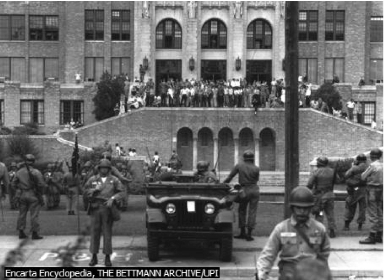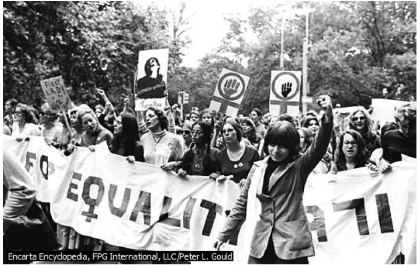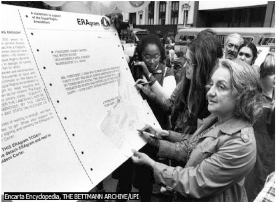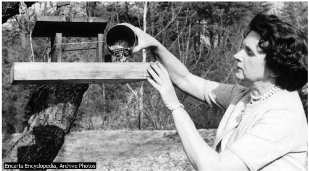B
Although the American economy developed very fast after World WarⅡ,many people did not benefit from it.In addition,many people felt that they were not treated equally politically and socially and demanded changes.Consequently,the 1960s saw a wide range of movements for social change.The Civil Rights Movement,the Women’s Liberation Movement,and the Environmental Movement brought great changes to American society.As a result,although women and racial minorities are still economically disadvantaged today,American society in the 21st century is much more liberal and open than in the 1950s.
1)The Civil Rights Movement
The Civil Rights Movement was a political,legal and social movement to achieve full citizenship and social equality for African Americans.Although the Emancipation Proclamation liberated blacks from slavery,and the 14th and 15th Amendments to the U.S.Constitution legally granted them citizenship and the right to vote right after the Civil War in the 1860s,African Americans were still suffering from racial prejudice and discrimination almost a century later.They generally worked in the lowest⁃paying jobs and lived in segregated areas,especially in the South.The Southern states had segregation laws in force which segregated public places such as buses,movie theaters,bathrooms,schools,etc.After about half a century of fight against segregation,the National Association for the Advancement of the Colored People(NAACP)won its first victory in 1953.The U.S.Supreme Court ruled in Brown v.Board of Education that segregation in education was unconstitutional.But some southern states refused to obey the court’s ruling and used violence to keep blacks away from white schools.In Little Rock Arkansas,President Eisenhower had to deploy federal troops to enforce the court’s decision.

Federal troops were used to provide safe passage for black students to Little Rock’s Central High School in 1957.
By the mid⁃1950s,more and more black people refused to accept segregation and the Civil Rights Movement began.The movement started in 1955,when Rosa Parks,a black woman in Montgomery,Alabama,refused to give up her seat to a white man and was arrested.When the news went out,the black community in Montgomery was outraged.They organized a boycott of the city buses,and under the leadership of Martin Luther King,Jr.,a black clergyman,the boycott developed into a broader movement.By the 1960s,many civil rights organizations were formed in the South.They held demonstrations in various forms,including sit⁃ins at segregated lunch counters.Northern white students also participated in the movement,including to show their support for the blacks’cause by riding with black students on segregated buses.
In March 1963,King organized the Civil Rights March on Washington.About 200,000 people gathered in front of the Lincoln Memorial,where King delivered his landmark“I Have a Dream”speech.
In 1964,Congress passed the Civil Rights Act which prohibited racial segregation in public places and barred racial discrimination in employment.The Voting Rights Act of 1965 eliminated literacy tests and other voter qualification tests which had prevented blacks from voting in the South.As a result,more and more blacks voted in elections.In 1973,people in Atlanta elected their first black mayor.
The federal government also adopted affirmative action policies to promote the employment of minorities,especially blacks,and women in order to promote equality.Affirmative action has caused intense debate.Many critics,especially white males,believe that affirmative action violates the principle of equality under the law because it gives certain people preferential treatment based on their race or gender.They argue that it amounts to“reverse discrimination”against white men.Many people challenged affirmative action policies in court.In a 1978 case,Regents of the University of California v.Bakke,the U.S.Supreme Court ruled that it was unconstitutional for schools to reserve a certain number of places for certain racial or ethnic groups,but that factors such as race and gender could be used in their evaluation of applicants.Affirmative action became a central issue in both national and state politics during the 1990s;California banned affirmative action in 1996 and Washington State followed suit in 1998.The Supreme Court and the nation as a whole remain divided on this issue today.
2)Student Movement
The 1960s also saw many student protests.Many young people were not satisfied with traditional values and rebelled in various ways.In 1960,students at the University of Michigan and other elite universities such as Harvard,Columbia,and University of Wisconsin organized the Students for Democratic Society which was aimed to reform American politics and society.They demanded that important issues should be decided by all American citizens instead of just the elites.They demonstrated against capital punishment and the violation of civil rights.The biggest demonstration,however,was against the Vietnam War.In order to protest the draft,many young people burned draft cards and mobbed recruitment officers from the army.About 40,000 young men went to Canada or Sweden to escape the draft.
Students also demonstrated against the arbitrary rules of the university and demanded participation in the setting of school rules.In 1964,students at Berkeley shut down the school for two months.In 1968,students at Columbia University took over several buildings in their Protest against racism and the university’s role in the Vietnam War.When the New York police tried to use force to regain control of the university,students in more than one hundred universities throughout the nation held demonstrations.
Besides political movements,the young people were also engaged in countercultural activities.The Hippies of the 1960s rebelled against traditional values,rejected what they viewed as Western materialism,and practiced a kind of nonviolent anarchy.They grew long hairs and beard,wore strange clothes,smoked marijuana,and advocated free sex.Another anti⁃cultural group of the 1960s was the Yippies(short for Youth Party International)who opposed capitalism,demanded an end to racism and the Vietnam War,and advocated“sex and drugs and rock’n’roll”.These groups were popular among young people.On August 15,16,and 17,1969,about 400,000 young people attended the Rock festival that took place near Woodstock,New York,which marked the high point of the countercultural movement.
3)Women’s Movement

Women’s Rights Movement
Women had played a central role in many workplaces during World WarⅡ,but most were replaced by returning soldiers after the end of World WarⅡand returned to traditional domestic roles.Women spent more time at home than before because of larger family sizes due to the postwar baby boom.Maternity,humility,and selfsacrifice were the qualities in women always valued by middle⁃class Americans.Those women who did work outside the home almost always received less pay than their male counterparts.Even within Civil Rights organizations,women were not treated equally;they were expected to make coffee while men made the decisions.
Meanwhile,increasing numbers of women attended college in the 1960s and they were eager to develop their own careers.As a result,they began to challenge traditional views about women and to fight for equality with men.The feminist leader Betty Freidan described the home as the“comfortable concentration camp”in her book The Feminine Mystique,and advocated that women should seek self⁃fulfillment.In 1966,she organized the National Organization for Women(NOW)whose objectives are to increase educational,political,and economic opportunities for women,and to end discrimination based on gender.This started the women’s liberation movement.NOW supported more flexible divorce laws,the repeal of anti⁃abortion laws,increased access to childcare services for working mothers,and equal pay for equal work.More radical feminists rejected traditional family structures.They began to decline to take their husbands’family names and used the title“Ms.”instead of the traditional“Miss”or“Mrs.”before their names because those titles indicated marital status.

Betty Friedan
The women’s liberation movement accom⁃plished a lot in its fight for equality with men.Today,more women have got higher education than before.Many careers which were previously considered exclusive to men are now open to women.In 1976,the United States Military Academy at West Point began to admit female cadets.Women are also more involved in politics;greater numbers of women are holding elected offices than in the past.
The increase in women working outside the home has left less time for family activities.Birth rates fell to an all⁃time low during the 1970s and divorce rates increased by 66% in the same period.Premarital sex became more popular in part because of the availability of oral contraceptives and the Supreme Court’s legalization of abortion in 1973.However,the abortion issue has been bitterly contested since 1973.The pro⁃choice side of the debate argues that women should have the right to control their own body,including the right to choose to have an abortion,while the pro⁃life side opposes abortion,arguing that a fetus is a human being and has the right to life.
People’s attitudes toward marriage have changed as well.Americans no longer pay as much attention to the formalities and legalities of marriage and divorce,instead putting more emphasis on personal compatibility and companionship.As of 1997,more than half of all women with children under the age of 6 had never been married.In the same year,13% of all American families were headed by a single parent.This trend continues today,and although the Republican Party has been arguing for family values,it appears unlikely that Americans will return to traditional family lifestyles.
4)Environmental Movement

Rachel Carson.Her 1962 book,Silent Spring led to a ban on the use of DDT.
The United States has a long history of environmental protection.As early as the 1830s,the transcendentalists expressed reverence for the natural world,believing that humans and nature shared a divine spirit.Naturalist John Muir established the Sierra Club in 1892 with the goal of protec⁃ting nature and wildlife.Around the turn of the century,President Theodore Roosevelt led a conservation movement to protect the nation’s forests and greatly expand the national park system.In the 1930s,President Franklin Roosevelt continued the con⁃servation tradition by organizing the Civilian Conservation Corps to plant trees and taking other measures to protect the land.In 1962,Rachel Carson published the book Silent Spring,in which she issued a warning that the indiscriminate use of pesticide,especially DDT,would do tremendous damage to nature and to humans themselves,and called on people to take action to protect the environment.
However,it was Earth Day in 1970 and the events leading up to it that caused the greatest change in Americans’attitudes toward the environment.Students organized“save the earth”activities to draw attention to the deteriorating condition of the environment.Many grassroots environmental groups appeared around this time,such as Greenpeace and the Natural Resource Defense Council.
In 1970,President Nixon established the Environmental Protection Agency to lead the government’s efforts to protect the Environment.In the same year,Congress passed the National Environmental Policy Act which provided that all federally funded projects should have an environmental assessment.The Clean Air Act and Clean Water Act were also passed in the early 1970s.In 1980,Congress passed the Comprehensive Environmental Response,Compensation,and Liability Act.The Act established a fund of﹩15 billion in public money,known as Superfund,to clean up polluted sites.
Conservatives have criticized environmental laws,especially since President Reagan’s administration,arguing that environmental restrictions hurt the economy and lead to job losses.Many leading corporations have spent of money fighting against environmental protection laws.
However,the general awareness of environmental issues among the public has greatly increased.For example,most Americans today routinely sort their garbage into different categories for recycling.
